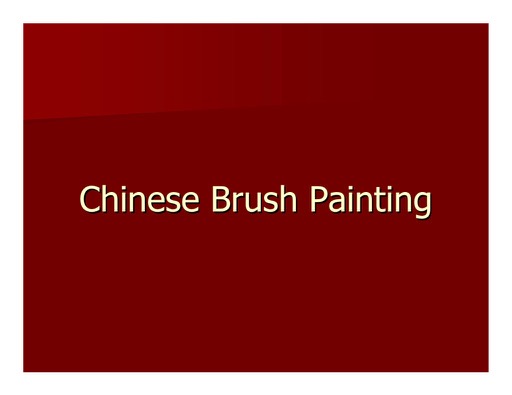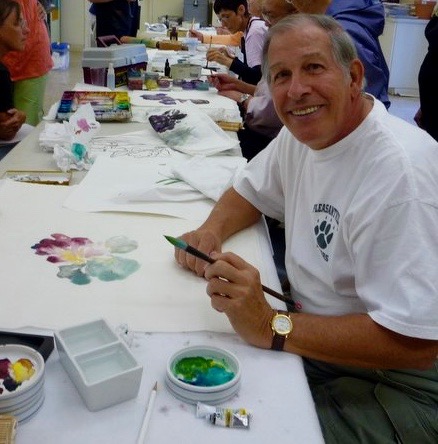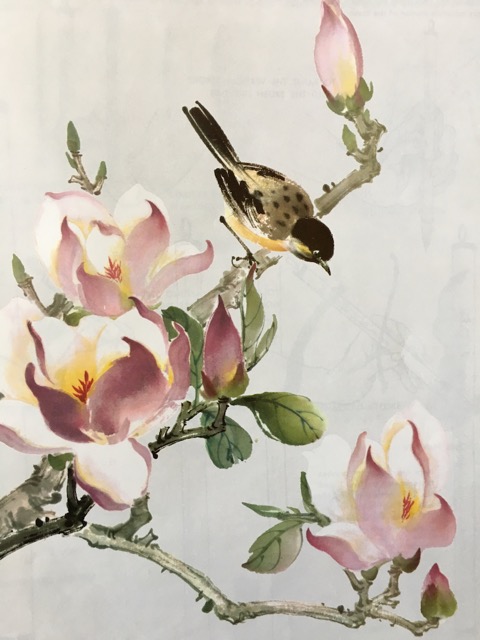
Painting conveys poetry, just as poetry embodies painting.
Three Styles of Painting:
CHINESE BRUSH PAINTING
*Xieyi (Spontaneous expressive brushstrokes)
*Gong-bi (Meticulous/Fine line brushwork)
*Mixed (Detail and spontaneous)

Painting Iris in Xieyi Style at Lung Hsiang Workshop 
Painting Wisteria in Studio
Chinese painting has developed continuously over a period of more than six thousand years. Over the past several years, I’ve come to specialize in the traditional Gong-bi style, often referred to as “court style” painting. Gong-bi has tremendous meaning and is yet another discipline rooted among the long and enriched history of Chinese Brush Painting. In the word “Gong Bi”, Gong takes the sense of “meticulous or delicate.” “Bi” generally indicates the tools for writing, but it also means of “to write.” The technique of Gong Bi seeks the delicacy, the precision of the details and vivid colors. It includes a collaboration of two artistries, calligraphy and brush painting. Also, it requires a specific technique, intricate line work, and a great deal of patience. Specializing in this style of painting requires my total concentration and a full reservoir of energy.
Commonly known as the art of fine line painting, “the technique of this style involves a strong foundation in calligraphy lines, then drawing an ink outline onto the paper and finally adding color in thin layers of wash. Sometimes nine to fourteen layers can be applied before the desired color depth, gradation, and intensity is reached.”
There are two styles of Chinese brush painting: free style/spontaneous and fine line/meticulous. With evolution, there is now a combination style of the two (mixed style.)
Xieyi “Paint the Idea” – This is a spontaneous style of the “bone-treatment-of-line” method. Space is defined, but details are often not filled in fully. The quality of brush strokes keeps line quality strong and expressive. Colors of paint are loaded on the brush one at a time, and there is only one opportunity (one line) to apply the paint. A strong line inevitably suggests an inner, flowing movement.
Gong-bi – Subjects are meticulously painted in detail, in an almost photographic approach. The objects are defined by first painting their outlines. Color is then applied within the boundaries on the sized (alum- glue solution) applied onto the raw Xuan rice paper. Gradations of color are achieved by applying a layer of paint then dragging a wet brush over that color. That layer is allowed to dry. For more intense colors, additional layers are applied. Up to nine layers may be applied in any one area as the colors float on the surface of the paper. This painting style was most commonly limited to professional painters and eventually largely gave way to Xieyi painting.
Mixed Style – Some objects are painted with detail while others are created spontaneously. Mostly, the focal points are detailed and the other are freestyle. The main figure (such as the bird or insect), is painted in the (Gong-bi) fine line style. The background plants are painted in the (Xieyi) free style.
Sometimes, I think that the morning sun seems to shine just for artists. You may not agree with the exact order of things, or understand why they turn out the way they do, but you take great pleasure as it all unfolds.

Xieyi Style -Dancing Spirit of Spring 
Gong-bi Style – Summer Roses

PASSAGES
As a perennial student of Asian arts and culture, I am continually focused on enhancing and sharing my knowledge and resources regarding aesthetic and artistic customs. Another objective is to promote the study and practice of Asian brush arts and culture and foster a greater appreciation and participation in related activities.